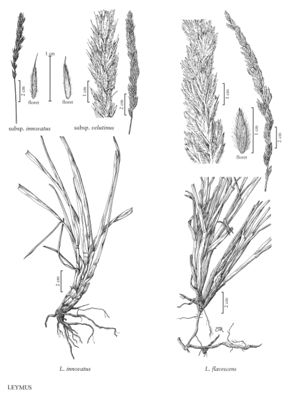Difference between revisions of "Leymus innovatus"
FNA>Volume Importer |
imported>Volume Importer |
||
| (8 intermediate revisions by 2 users not shown) | |||
| Line 4: | Line 4: | ||
|publications= | |publications= | ||
|common_names=Downy ryegrass;Boreal wildrye | |common_names=Downy ryegrass;Boreal wildrye | ||
| + | |special_status={{Treatment/ID/Special_status | ||
| + | |code=E | ||
| + | |label=Endemic | ||
| + | }} | ||
|basionyms= | |basionyms= | ||
|synonyms={{Treatment/ID/Synonym | |synonyms={{Treatment/ID/Synonym | ||
|name=Elymus innovatus subsp. velutinus | |name=Elymus innovatus subsp. velutinus | ||
| − | |authority= | + | |authority= |
| − | }}{{Treatment/ID/Synonym | + | |rank=subspecies |
| + | }} {{Treatment/ID/Synonym | ||
|name=Elymus innovatus | |name=Elymus innovatus | ||
| − | |authority= | + | |authority= |
| + | |rank=species | ||
}} | }} | ||
|hierarchy=Poaceae;Poaceae subfam. Pooideae;Poaceae tribe Triticeae;Leymus;Leymus innovatus | |hierarchy=Poaceae;Poaceae subfam. Pooideae;Poaceae tribe Triticeae;Leymus;Leymus innovatus | ||
| Line 23: | Line 29: | ||
-->{{Treatment/Body | -->{{Treatment/Body | ||
|distribution=Alta.;B.C.;Man.;N.W.T.;Ont.;Sask.;Yukon;Colo.;Alaska;Mont.;Wyo.;S.Dak. | |distribution=Alta.;B.C.;Man.;N.W.T.;Ont.;Sask.;Yukon;Colo.;Alaska;Mont.;Wyo.;S.Dak. | ||
| − | |discussion=<p>Leymus innovatus is a North American species that grows in open woods and forests, riverbanks, open prairies, and rocky soils, and often in sandy, gravelly, or silty soils, primarily from northern Alaska to Hudson Bay, and south into the Black Hills region of Wyoming and South Dakota. Morphologically, the two subspecies show some overlap. Bowden recognized them in part because of their difference in ploidy level.</p> | + | |discussion=<p><i>Leymus innovatus</i> is a North American species that grows in open woods and forests, riverbanks, open prairies, and rocky soils, and often in sandy, gravelly, or silty soils, primarily from northern Alaska to Hudson Bay, and south into the Black Hills region of Wyoming and South Dakota. Morphologically, the two subspecies show some overlap. Bowden recognized them in part because of their difference in ploidy level.</p> |
|tables= | |tables= | ||
|references= | |references= | ||
| Line 46: | Line 52: | ||
-->{{#Taxon: | -->{{#Taxon: | ||
name=Leymus innovatus | name=Leymus innovatus | ||
| − | |||
|authority=(Beal) Pilg. | |authority=(Beal) Pilg. | ||
|rank=species | |rank=species | ||
| Line 53: | Line 58: | ||
|basionyms= | |basionyms= | ||
|family=Poaceae | |family=Poaceae | ||
| + | |illustrator=Cindy Roché | ||
| + | |illustration copyright=Utah State University | ||
|distribution=Alta.;B.C.;Man.;N.W.T.;Ont.;Sask.;Yukon;Colo.;Alaska;Mont.;Wyo.;S.Dak. | |distribution=Alta.;B.C.;Man.;N.W.T.;Ont.;Sask.;Yukon;Colo.;Alaska;Mont.;Wyo.;S.Dak. | ||
|reference=None | |reference=None | ||
|publication title= | |publication title= | ||
|publication year= | |publication year= | ||
| − | |special status= | + | |special status=Endemic |
| − | |source xml=https:// | + | |source xml=https://bitbucket.org/aafc-mbb/fna-data-curation/src/200273ad09963decb8fc72550212de541d86569d/coarse_grained_fna_xml/V24/V24_527.xml |
|subfamily=Poaceae subfam. Pooideae | |subfamily=Poaceae subfam. Pooideae | ||
|tribe=Poaceae tribe Triticeae | |tribe=Poaceae tribe Triticeae | ||
Latest revision as of 16:24, 11 May 2021
Plants sometimes cespitose, strongly rhizomatous. Culms 18-105 cm tall, 2-3 mm thick. Leaves exceeded by the spikes; sheaths glabrous or hairy, often most densely hairy in the collar region; auricles to 1.4 mm; ligules 0.1-0.5 mm; blades 2-6 mm wide, involute, abaxial surfaces scabridulous or smooth, adaxial surfaces scabrous, occasionally with scattered hairs to 1.5 mm, veins unequal, not crowded. Spikes 3-16 cm long, 8-20 mm thick, erect, usually well exserted, with 2-3 spikelets per node; internodes 4-6 mm, hairy throughout, edges with hairs to 2.5 mm. Spikelets 10-18 mm, with 3-7 florets. Glumes often unequal, sometimes absent, 2.5-12 mm long, 0.5-1 mm wide, hairy, stiff, keeled, the central portion thicker than the margins, bases not overlapping, tapering from near the base to the subulate apices, 0-1(3)-veined, veins inconspicuous at mid-length; calluses hairy; lemmas 7-12 mm, usually conspicuously villous or velutinous, occasionally glabrate, hairs 0.7-2.5 mm, awned, awns 2-4 mm; anthers 3.5-10 mm, dehiscent. 2n = 28, 56.
Distribution
Alta., B.C., Man., N.W.T., Ont., Sask., Yukon, Colo., Alaska, Mont., Wyo., S.Dak.
Discussion
Leymus innovatus is a North American species that grows in open woods and forests, riverbanks, open prairies, and rocky soils, and often in sandy, gravelly, or silty soils, primarily from northern Alaska to Hudson Bay, and south into the Black Hills region of Wyoming and South Dakota. Morphologically, the two subspecies show some overlap. Bowden recognized them in part because of their difference in ploidy level.
Selected References
None.
Key
| 1 | Spikes 8-16 cm long, 8-15 mm wide; lemma hairs 0.7-2.5 mm long | Leymus innovatus subsp. innovatus |
| 1 | Spikes 3-8 cm long, 15-20 mm wide; lemma hairs 1.5-2.5 mm long | Leymus innovatus subsp. velutinus |
